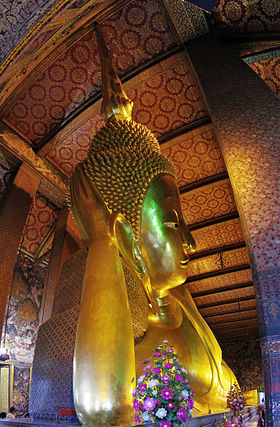Wat Pho
| Wat Pho | |
|---|---|

View of the Reclining Buddha
|
|
| Basic information | |
| Geographic coordinates | 13°44′47″N 100°29′37″E / 13.74639°N 100.49361°ECoordinates: 13°44′47″N 100°29′37″E / 13.74639°N 100.49361°E |
| Affiliation | Theravada Buddhism |
| Country | Thailand |
| Website | www.watpho.com |
| Architectural description | |
| Founder | Unknown King Rama I (re-establishment) |
| Completed | 16th century 1788 CE (re-establishment) |
Wat Pho (Thai: วัดโพธิ์, IPA: [wát pʰoː]), also spelt Wat Po, is a Buddhist temple complex in the Phra Nakhon District, Bangkok, Thailand. It is on Rattanakosin Island, directly south of the Grand Palace. Known also as the Temple of the Reclining Buddha, its official name is Wat Phra Chetuphon Vimolmangklararm Rajwaramahaviharn (Thai: วัดพระเชตุพนวิมลมังคลารามราชวรมหาวิหาร; rtgs: Wat Phra Chettuphon Wimonmangkhlaram Ratchaworamahawihan; IPA: [wát pʰráʔ tɕʰê:t.tù.pʰon wíʔ.mon.maŋ.kʰlaː.raːm râːt.tɕʰá.wɔː.ráʔ.má.hǎː.wíʔ.hǎːn]). The more commonly known name, Wat Pho, is a contraction of its older name Wat Photaram (Thai: วัดโพธาราม; rtgs: Wat Photharam).
The temple is first on the list of six temples in Thailand classed as the highest grade of the first-class royal temples. It is associated with King Rama I who rebuilt the temple complex on an earlier temple site, and became his main temple where some of his ashes are enshrined. The temple was later expanded and extensively renovated by Rama III. The temple complex houses the largest collection of Buddha images in Thailand, including a 46 m long reclining Buddha. The temple is considered the earliest centre for public education in Thailand, and the marble illustrations and inscriptions placed in the temple for public instructions has been recognised by UNESCO in its Memory of the World Programme. It houses a school of Thai medicine, and is also known as the birthplace of traditional Thai massage which is still taught and practiced at the temple.
...
Wikipedia

